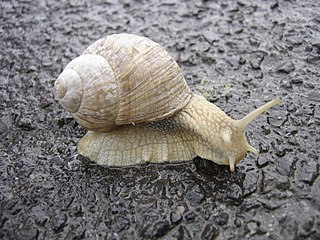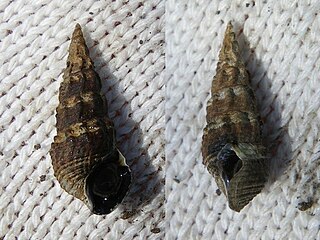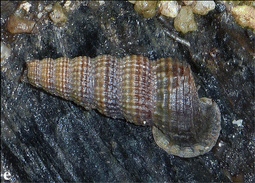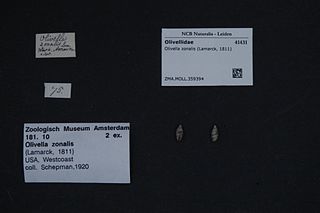
A snail is a shelled gastropod. The name is most often applied to land snails, terrestrial pulmonate gastropod molluscs. However, the common name snail is also used for most of the members of the molluscan class Gastropoda that have a coiled shell that is large enough for the animal to retract completely into. When the word "snail" is used in this most general sense, it includes not just land snails but also numerous species of sea snails and freshwater snails. Gastropods that naturally lack a shell, or have only an internal shell, are mostly called slugs, and land snails that have only a very small shell are often called semi-slugs.

Gastropods, commonly known as slugs and snails, belong to a large taxonomic class of invertebrates within the phylum Mollusca called Gastropoda.

Jean Guillaume Bruguière was a French physician, zoologist and diplomat.

The operculum is a corneous or calcareous anatomical structure like a trapdoor that exists in many groups of sea snails and freshwater snails, and also in a few groups of land snails; the structure is found in some marine and freshwater gastropods, and in a minority of terrestrial gastropods, including the families Helicinidae, Cyclophoridae, Aciculidae, Maizaniidae, Pomatiidae, etc.

Terrestrial animals are animals that live predominantly or entirely on land, as compared with aquatic animals, which live predominantly or entirely in the water, and amphibians, which rely on aquatic and terrestrial habitats. Some groups of insects are terrestrial, such as ants, butterflies, earwigs, cockroaches, grasshoppers and many others, while other groups are partially aquatic, such as mosquitoes and dragonflies, which pass their larval stages in water.

Sea snail is a common name for slow-moving marine gastropod molluscs, usually with visible external shells, such as whelk or abalone. They share the taxonomic class Gastropoda with slugs, which are distinguished from snails primarily by the absence of a visible shell.

The gastropod shell is part of the body of a gastropod or snail, a kind of mollusc. The shell is an exoskeleton, which protects from predators, mechanical damage, and dehydration, but also serves for muscle attachment and calcium storage. Some gastropods appear shell-less (slugs) but may have a remnant within the mantle, or in some cases the shell is reduced such that the body cannot be retracted within it (semi-slug). Some snails also possess an operculum that seals the opening of the shell, known as the aperture, which provides further protection. The study of mollusc shells is known as conchology. The biological study of gastropods, and other molluscs in general, is malacology. Shell morphology terms vary by species group.

Zeacumantus is a genus of small to medium-sized sea snails or mud snails, marine gastropod mollusks in the family Batillariidae.

Zeacumantus subcarinatus, common name the southern creeper, is a species of small sea snail or mud snail, a marine gastropod mollusc in the family Batillariidae.

Batillaria is a genus of small salt marsh or mudflat snails, marine gastropod mollusks in the family Batillariidae, the horn snails.

Naticarius is a genus of predatory sea snails, marine gastropods in the subfamily Naticinae of the family Naticidae, the moon snails.

Batillariidae, common name batillariids or mudcreepers, are a family of marine, cerithioidean gastropod molluscs in thesuperfamily Cerithioidea.

Freshwater snails are gastropod mollusks that live in fresh water. There are many different families. They are found throughout the world in various habitats, ranging from ephemeral pools to the largest lakes, and from small seeps and springs to major rivers. The great majority of freshwater gastropods have a shell, with very few exceptions. Some groups of snails that live in freshwater respire using gills, whereas other groups need to reach the surface to breathe air. In addition, some are amphibious and have both gills and a lung. Most feed on algae, but many are detritivores and some are filter feeders.

Cerithidea is a genus of medium-sized sea snails or mud snails, marine gastropod mollusks in the family Potamididae, the horn snails.

Olivella zonalis is a species of small sea snail, marine gastropod mollusk in the subfamily Olivellinae, in the family Olividae, the olives. Species in the genus Olivella are commonly called dwarf olives.

Batillaria attramentaria, common name the Japanese mud snail, is a marine gastropod mollusk in the family Batillariidae. It is a species of sea snail most often found in the salt marshes and mudflats of marine, estuarine, riparian and wetland habitats. Introduced to North America between the 1920s to 1930s via the coasts of Washington and California, the Japanese mud snail became an invasive species notorious for reducing biodiversity by outcompeting the native hornsnail Cerithidea californica.

Batillaria australis is a species of sea snail, a marine gastropod mollusk in the family Batillariidae.

Batillaria multiformis is a species of sea snail, a marine gastropod mollusk in the family Batillariidae.
Batillaria sordida is a species of sea snail, a marine gastropod mollusk in the family Batillariidae.

Cerithideopsis californica, common name the California hornsnail or the California horn snail, is a species of sea snail, a marine gastropod mollusk in the family Potamididae. This series was previously known as Cerithidea californica.




















